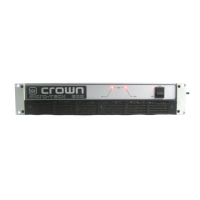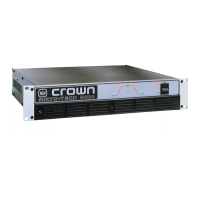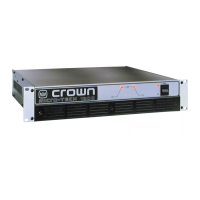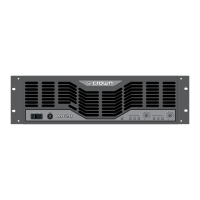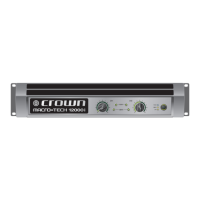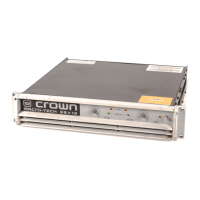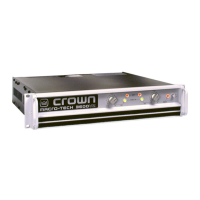Page 15
Micro-Tech 600/1200/2400 Power Amplifiers
SOLVING INPUT PROBLEMS
Sometimes large subsonic (subaudible) frequencies
are present in the input signal. These can damage
loudspeakers by overloading or overheating them. To
attenuate such frequencies, place a capacitor in se-
ries with the input signal line. The graph in Figure 3.10
shows some possible capacitor values and how they
affect frequency response. Use only low-leakage pa-
per, mylar or tantalum capacitors.
+
–
Balanced In
910 Ω
.003
fµ
.015
fµ
.018
fµ
1.8 mH
2.5 mH
A
C
B
.015
fµ
1.8 mH
D
Balanced Out
+
–
910 Ω
1.8 mH
2.5 mH
1.8 mH
+
–
Balanced In
Balanced Out
+
–
+
–
Balanced In
Balanced Out
+
–
+
–
Balanced In
Balanced Out
+
–
0.47 Film
0.47 Film
1 Hz 10 Hz 100 Hz 1 kHz 10 kHz
dB
0
–5
–10
–15
Frequency
0.047 µf
0.1 µf
0.47 µf
1.0 µf
0.22 µf
Fig. 3.10 Subsonic Filter Capacitors
For balanced input wiring, use one of the examples in
Figure 3.12. Filters A, B and C correspond to the un-
balanced filters above. Filter D also incorporates the
subsonic filter described previously.
Another problem to avoid is
grgr
grgr
gr
ound loopsound loops
ound loopsound loops
ound loops. These are
undesired currents that flow in a grounded system and
Fig. 3.12 Balanced RF Filters
usually cause hum in the output. A common source of
ground loop problems is the placement of input cables
parallel to power cables or near power transformers.
The magnetic field that surrounds these conductors
can induce the 50 or 60 Hz alternating current into your
input cables. To prevent this type of ground loop, it is
always a good idea to locate input cables away from
power cables and power transformers. We also rec-
ommend using shielded or twisted pair wire. With loose
wires, use tie-wraps to bundle together each pair of
input wires. This helps reduce magnetically-induced
current by minimizing the cross-sectional area between
Input Wiring Tips
1. Use only shielded cable. Cables with
higher density shields are better. Spiral
wrapped shield is not recommended.
2. When using unbalanced lines, keep the
cables as short as possible. Avoid cable
lengths greater than 10 feet (3 meters).
3. Do not run signal cables together with
high-level wiring such as loudspeaker wires
or AC cords. This reduces the chance of hum
or noise being induced into the input cables.
4. Turn off the entire system before chang-
ing connections. Turn down the level controls
(fully counterclockwise) before powering the
system back up. Crown is not liable for dam-
age incurred when any transducer or com-
ponent is overdriven.
Another problem to avoid is the presence of large lev-
els of radio frequencies or RF in the input signal. Al-
though high RF levels may not pose a threat to the
amplifier, they can burn out tweeters or other loads that
are sensitive to high frequencies. Extremely high RF
levels may also cause the amplifier to prematurely ac-
tivate its protection circuitry. RF can be introduced into
an input signal by local radio stations or the bias signal
of many tape recorders. To prevent RF problems, in-
stall appropriate low-pass filters on the inputs. Ex-
amples are shown below for unbalanced wiring:
4 kHz 10 kHz 40 kHz 100 kHz
Fre
uenc
dB
0
–10
–20
A
B
C
6 dB/octave
12 dB/octave
To
Amp
GND
To
Amp
GND
To
Amp
GND
Source
1.8 K ohm
.003
fµ
.015
f
µ
.018
fµ
3.9 mH
5 mH
600 ohm
Source
R
600 ohm
Source
R
A
C
B
Note: A low source impedance (R) can be
increased to 600 ohms with an a
ro
riate resistor.
Fig. 3.11 Unbalanced RF Filters

